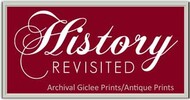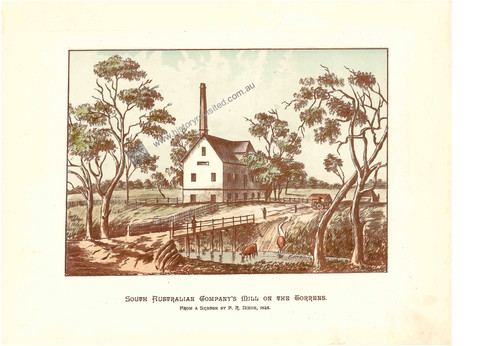 Loading... Please wait...
Loading... Please wait...All prices are in All prices are in AUD
Categories
- Home
- Giclee Prints
- South Australia, Company’s Mill, Torrens, Hackney, Nixon
- Home
- Giclee Prints
- South Australian Scenes
- South Australia, Company’s Mill, Torrens, Hackney, Nixon
Product Description
Giclee Process, Hackney, Steam Mill, South Australia Company, Frederick Robert Nixon, 1845, John Stevens
"South Australian Company's Mill on the Torrens. From a Sketch by F.R. Nixon 1845"
Size of image = 13.8 x 19.6 cm ( 51/2 x 72/3 inch)
Limited Edition Archival quality Giclee after an original chromolithograph Wigg & Son in 1886 from Original Sketch by F.R Nixon of Adelaide in 1845. The Scene features a two-story steam mill with a tall chimney stack to the left (eastern side), the roof-line is steep with one peaked window feature facing West (offering a few of the city of Adelaide). The structure is on the other side of what was called The Company's Bridge (later Hackney Bridge), one of the earlier structures, as the river often washed bridges away. Two Cows are standing in the shallow River Torrens drinking the water while a man with a top-hat is facing west, holding the bridge railing. Another two men walk towards the driver of a wagon and horse across on the southern bank. The wagon is waiting in front of two red roofed cottages behind two gum trees. There is a picket timber fence around the paddock behind the gentleman, with further fences seen around the Mill & paddocks in the distance. I suspect this is Park Farm that is part of the Mill tenancy. Gum trees are dispersed across the scene. A small dirt track, used by the cattle to reach the water, can be seen on the opposite bank. Beyond the cottages is where St. Peter's College was finally located in 1854, being to subject of the future suburb name of College Park.
Other Giclee prints by F.R. Nixon in this series available: Government House and Part of North Terrace East View, Hindley Street Looking West, Port Adelaide
Story behind the Sketch: John Stevens, Miller.
Originally this series of sketches was printed in chromo-lithography after the original sketch artist, Frederick Robert Nixon (1817-1860), who had been a surveyor/draughtsman in Colonel Willliam Light's survey Team. He went on to build & run Nixon's Mill near Hahndorf, that ceased operation in 1864, but has survived wind and vandal damage, being restored in 1985. E.S (Edgar Smith) Wigg & Son published the "Twelve Views of Adelaide and its Vicinity" in 1886. He includes another mill in these views, that of the City Mill on Lot 464, such was the importance of grain in the new colony). Wigg & Co. setup in the colony as publishers and stationary sellers. Having retail stores in several locations, they built a substantial retail store at 65 Grenfell Street in 1921,. It was heritage listed in November 2001, the year of South Australia's Centenary of Federation. My interest in the South Australia Company's Mill is as one of John Stevens great-great-grand-daughters, a settler that arrived in 1837 from Chichester, West Sussex. Sadly, all that remains of the mill is an information board on the River Torrens across from Hackney Hotel where Park Farm & the cottage where John Stevens and his family lived as part of the Mill's lease. Previously he had built a steam mill at Noarlunga in 1841, that now survives as a beautiful family home. As a miller by trade, he had a formed a partnership, Stevens, Phillips & Dehorne. In The Register, 9 April 1923, entitled Adelaide's First Mills: "The South Australian Company’s steam mill on the Torrens, near the Hackney Hotel, was one of the best and largest mills. It had four pairs of stones, and was leased by Mr Ridley, of the Hindmarsh mill. It was fully described in The Southern Australian (14/4/43 p.2, c.3) also in the Register (2/2/60 p.2,c.1) Its engine was a watts Grasshopper type." Having already described the building of the fist wind -powered grain mill, on West Terrace/Wright Street lot 464. the article adds, "In 1845 Stevens, Phillip’s and Dehorne owned both mills." When Gold was discovered in the Eastern states in the 1850s he took advantage of the early Murray Riverboats, introduced by Captain William Randall, to take flour to where it was needed, as bread was a staple of the miners diet. Stevens was at the coal-face of adapting to new technology & opportunities or suffer the consequences. He chose to meet those challenges and adapt.











